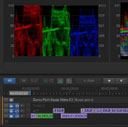At NAB 2012 Adobe made an intriguing sneak peek at the technology for collaborative editing. At IBC 2012 Michael Coleman introduced the new Adobe Anywhere and presented its integration with Adobe Premiere. Like most demos, this one looked pretty impressive, and even gave away a few interesting developments in the upcoming version of Premiere, but it also left me pondering on the larger picture.
Indeed, Mercury Streaming Engine’s performance seems impressive. Ability to focus on the whole production, instead of on its single aspect, automatic (?) file management (and backup?), use of relatively slow machines on complex projects, working at long distance – all this is really promising. There is no doubt about it. However…
No back end and management application was presented. No performance requirements were given. How soon does a server saturate its own CPU, GPU and HDD resources? Apart from performing all the usual duties, it must now also encode to the Adobe streaming codec, and all the horsepower must still come from somewhere. If the technology uses standard current frame servers developed for Dynamic Link and Adobe Media Encoder, how are the resources divided, and how is the Quality of Service ensured? How effective is the application, and more important – how stable? I hope the problems with database corruption in Version Cue are things of the past, and they will not happen with Anywhere at any time.
Adobe engineers have been working on the problem for about 4 years, so there is a high chance that my fears are unwarranted. At the same time though I’ve learnt not to expect miracles, and there will always be some caveats, especially with the early releases of the software.
Of course, it explains why Adobe wants to first target Anywhere to their broadcast clients. Perhaps there is some of the sentiment, that since the video division finally has the enterprise clients, it needs to take care of them – hopefully not at the expense of smaller businesses and freelance editors like me. But setting up the servers, managing hardware and the whole architecture, takes expertise, and it is mostly the big guys who have the resources to implement the recommendations. We still do not know what the entry-level cost is going to be, but I highly doubt it’s going to be cheap.
Not that small post-houses would not profit from Anywhere. I can easily see how it could be incorporated in our workflow, and how it could easily resolve a few problems that we have to manage on a daily basis. But will we be able to supply the back-end architecture? It remains to be seen.
Interestingly, this approach of beefing up one’s machine room contrasts another trend that we have been seeing – the horsepower of average desktops being more than enough to handle pretty complex projects. All this remains totally unused in the model promoted by Adobe Anywhere. I wonder what Walter Biscardi thinks of it, and does he plan on using it at all.
I’m also curious how the version control is resolved? How are the changes propagated – can you in some way unify the conflicting projects, or do you need to choose one over the other? It is important. I gather that you can always go back to previous versions, but will they be available only from administrative panel, or also from applications themselves? Only time will tell.
It’s good that there is a possibility of expanding the system. I think a natural application that will be developed very shortly after the release, will be some kind of review player, where you can see the recent final result of the project, add markers and possibly annotations (why not? as a Premiere Pro title for example). Especially useful for mobile platforms, like iPad, where Premiere or even Prelude is not available. Such tools could become crucial for the approval and collaborative workflow in general.
There is also another point, which gave rise to the question in the title of this note. Is it the conforming uber-app that I’ve been arguing for? From the limited demonstrations to date unfortunately the answer is still no. We are not there yet, even though Adobe Anywhere seems very promising for collaborative editing, it is not yet there for collaborative finishing (and archiving for that matter).
The elephant in the room seems to be client’s review and approval. It’s OK to serve a 1/4th resolution of the picture if you are editing on a laptop without an external monitoring. But once you get into the realm of finishing, especially with your client at the back, you want the highest quality picture that you can get, with as little compression as you can. Anywhere is most likely not going to be able to serve that. Would you have to leave the ecosystem then?
Even though the support exists for After Effects, Premiere Pro and Prelude, the holy grail still remains the ability to take Premiere’s project in its entirety and work on it in Audition or SpeedGrade, and then bring it back to Premiere for possible corrections in picture edit with all the changes made in other programs intact. Or to export an XML or EDL without a hassle of hours of preparation if custom plugins, effects or transitions are being used. Nope – not there yet.
There is also a question of its integration in larger, more diverse pipelines, involving other programs and assets, not only from Adobe, but from other vendors, like The Foundry or Autodesk. It’s true, that Anywhere does have it’s own API for developers, although it remains to be seen, how open and how flexible the system will be, especially in terms of asset management.
Yet, despite all these doubts and supposed limitations, it seems to be a step in the right direction. And, as Karl Soule claims, the release of Anywhere is going to be big.




